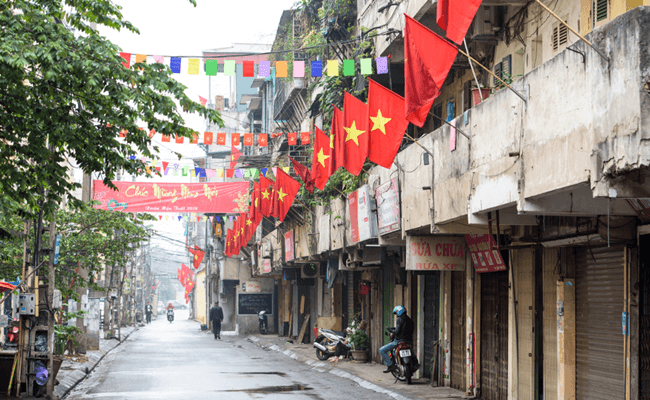Located about 20km southwest of Hanoi, along Highway 6, stands a limestone mountain amid a prosperous plain offering relic of Tu Tram Mountain.
When visiting the spot, the traveller is usually told the story of Mt. Tu Tram. In ancient times, the brightest and finest star of the heavens, Tu Vi, suddenly fell from the sky and has transformed into a mountain. The local people named it Mt. Tu Tram. In the Le Dynasty, in the seventh year of Canh Tri, 1669, a text was carved in the stone half way up its walls. The mountain was then called Mt. Long Chau or Mt. Phat Tich (the mountain embracing relics and traces of the Buddha).
Mt. Tu Tram is indeed a precious gift of nature. The landscape with its mountain and water is a Holy Land. Enamored with the beautiful landscape of Mt. Tu Tram, in 1516 King Le Chieu Tong had a royal stopover pavilion built and ordered the digging of canals and clearing of streams around the mountain for dragon-boat rides whenever he was free from national affairs. Quite a few religious structures such as altars and shrines, temples and pagodas were built during following dynasties. As a result, today, many architectural vestiges of different times are found, such as the Pagodas of Long Tien, Quan Yin, Vo Vi and Ba Lang, the Cao Son Temple, Mother’s Temple, stone-slab pavilions and towers. Due to the wear of ages and the devastation of wars and nature, some of the architectural relics could not be kept intact and others lie in ruins such as the tower and little temple on the southwestern slope of the mountain.
Long Tien Pagoda, also called Tram Pagoda, was erected in the 7th year of Canh Tri 1669. It has been repaired and restored several times. In the middle of its high stone floor perron stands a stone slab with a relief carving of two lizards. According to some Southeast Asian agricultural people, the lizard symbolizes the fire genie. A group of Buddha statues in the pagoda bears the style of 18-19th century art with very delicate and sophisticated curving lines.
Nature has endowed Mt. Tu Tram with picturesque caves and caverns. Long Tien is the most beautiful cave. Its mouth is not so large but its vault is immense. Hundreds of stalactites in every exotic and eerie form flow from the roof and the walls of the cave. In the 17th year of Chinh Hoa (1696), King Le Hy Tong had dozens of statutes of Buddha, giant guardians and sacred deities carved in the cave. This treasure trove is of immense historic and artistic value, particularly the statute of Amitabha. It portrays him in a zen position on a lotus, with a round, chubby upright face and half-closed eyes, in deep meditation and wearing a sympathetic and savory smile. The piece was masterfully carved with delicate lines in detailed animation. The roof and the walls of the cave still bear the autographs of more than ten famous scholars from the Posterior Le to the Nguyen dynasties. Present are 20 pre-eminent essays in prose and poetry in classical Vietnamese script (Han Nom) heaping praise upon the beautiful landscape of Mt. Tu Tram. This may be seen as a cavern of literary coterie, thud rendezvous of generations of poets. This treasure trove is of a historic and cultural value rarely seen in Vietnam.
In the area of Mt.Trao, very close to Mt. Tu Tram, a little shrine is found on top of a mountain: Vo Vi Pagoda built in 968 AD. Today, on the stone walls around the pagoda are found slabs with scriptures of great historical and artistic value. Each year, when spring comes round, the local people around Mt. Tu Tram hold the Tram Pagoda Festival on the second day of the second lunar month. In the festive atmosphere, village elders recount for the young generation the myths and legends of Mt. Tu Tram.






